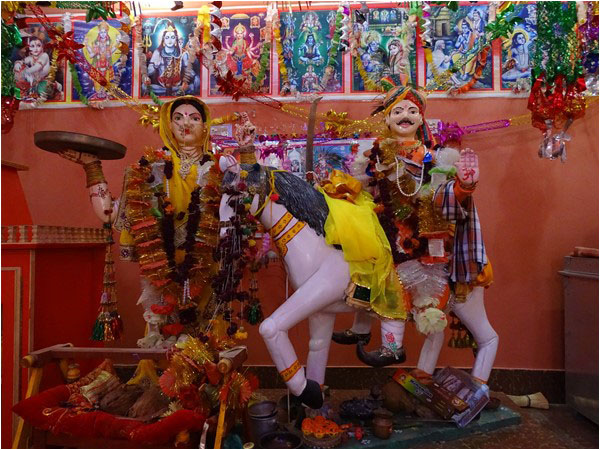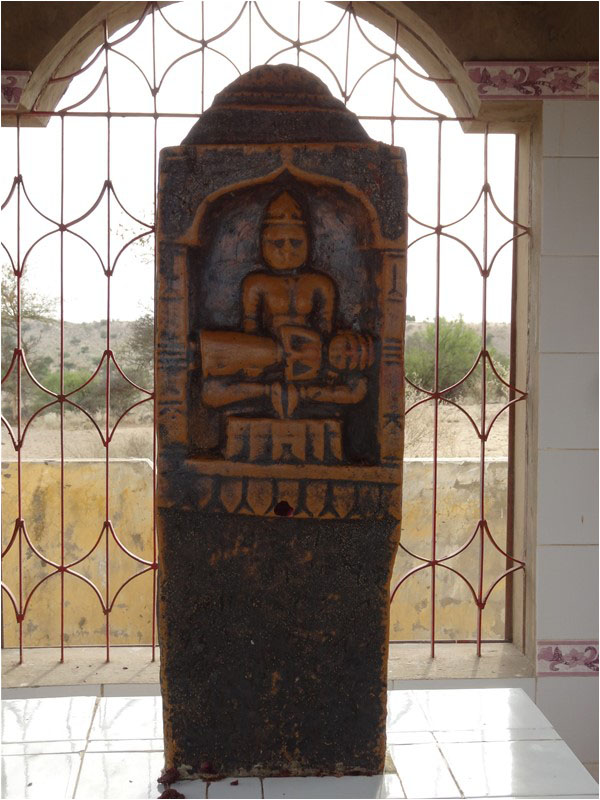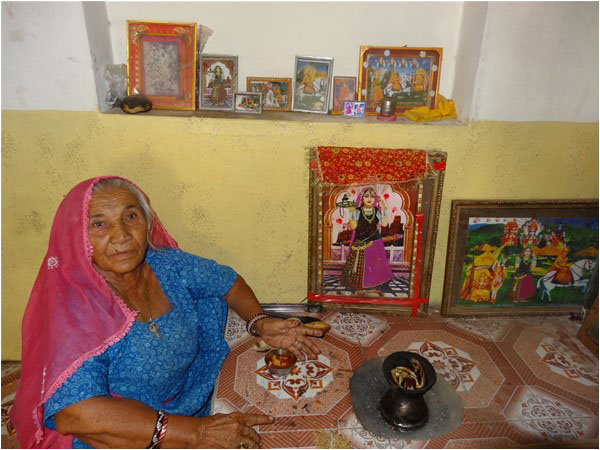
The origin of the rite is shrouded in mystery but according to well-known Hindu classical myths Sati, the wife of Shiva, committed suicide when her father insulted Shiva.
Zulfiqar Ali Kalhoro
The landscape of Tharparkar is marked by a number of shrines and temples where both lower and upper Hindu castes venerate satis in shared spaces.
The origin of the rite is shrouded in mystery but according to well-known Hindu classical myths Sati, the wife of Shiva, committed suicide when her father insulted Shiva. She threw herself into a sacrificial fire. Her name Sati, as many scholars believe, is a feminine form of the Sanskrit adjective sat meaning truth and the word ‘sati’ came to be applied specifically to the widow who immolated herself on her husband’s funeral pyre. The rite of Sati appears to have spread throughout India in the third century AD and became more prevalent and popular after the eighth century AD.
The custom of sati was banned by the British in 1829. Despite the ban on the rite, scattered incidents of widow-burning continued up to 1987. The last reported case was of an 18-year-old Roop Kanwar from Rajasthan, who cremated herself on the funeral pyre of her husband.
The practice of sati was also prevalent in Sindh – right from the Brahman dynasty in the seventh and eighth centuries to the creation of Pakistan in 1947. In Sindh the practice continued up to 1960 in Tharparkar. Before and after Partition, most of the Sati cases took place in Tharparkar. The last case from Tharparkar was of Gora Bai, who was a daughter of Konbho Charan of Mau village, which lies 5 km northeast of Nagarparkar town.
 The custom of sati was common amongst the Rajputs. Later it was also adopted by non-Rajput castes including Charans, Bhats, Kolis and others which were associated with Rajputs. Many Rajput and other and non-Rajput castes have kulsatis and kuldevis. The term kulsati refers to a family Sati. Kulsati or family Sati also acquired the status of a satimata if her cult extends beyond her family to the village and the region. When she acquires the status of regional cult, she is called satimata. Many Sati shrines, temples and monuments have been erected to venerate satis.
The custom of sati was common amongst the Rajputs. Later it was also adopted by non-Rajput castes including Charans, Bhats, Kolis and others which were associated with Rajputs. Many Rajput and other and non-Rajput castes have kulsatis and kuldevis. The term kulsati refers to a family Sati. Kulsati or family Sati also acquired the status of a satimata if her cult extends beyond her family to the village and the region. When she acquires the status of regional cult, she is called satimata. Many Sati shrines, temples and monuments have been erected to venerate satis.
They led the women to believe that ‘trial by fire’ was an act of truth (sat) and every woman proved her sati-hood (satitva) by showing no physical pain at the time of the ordeal
In most of the Hindu villages in Tharparkar, there are spaces commemorating Satis by building sati-thans (open platforms), sati-devri or dehro (small structures built of burnt bricks), sati-delhri (alcoves made of mud), madd (small domed alcove mud structures), sati oato (courtyards) and sati khambi (sati stones).
Some popular Sati shrines are located in Mithi, Islamkot, Chachro Diplo and Nagarparkar talukas of the Tharparkar district. Kasuma, a Kulsati of Dohat Rathores in Vejhiar, has acquired the status of a regional cult in Tharparkar. Two of her daughters, Phool Bai and Chanda Bai, also became satis. The memorial stone (khambi) of Phool Bai is located in old Mondarao village in Nagarparkar. Kasuma became sati with her son Harnath – who died on the battlefield. We are told that when his dead body was brought back to the village, the wife refused to immolate herself with the deceased husband – which was considered a bad omen. The practice of sati has been glorified by many communities of bards in Tharparkar over the centuries.
The idea is that a woman has to live with her husband in this world and the afterlife. If he dies, she has to die with him. The Charans, a bard community glorified sati and inculcated it so much that women preferred death over life and they were made to believe that after performing the rite they would acquire the status of devi (goddess). This, many of them did acquire in Rajasthan and Gujarat in India and Sindh in Pakistan. Through their folk poetry (chhands) the Charan poets equated the fire-bath (in which a woman immolated herself) to agnishnan. They led the women to believe that ‘trial by fire’ was an act of truth (sat) and every woman proved her sati-hood (satitva) by showing no physical pain at the time of the ordeal.
Not every sati acted voluntarily. Many satis were administered drugs especially hashish before performing the rite. Nor does this mean that every sati was forced to perform the rite. The majority of the known cases show that sati acted ‘of their own volition’. In the case of Kasuma, she became Sati with her son and became satimata.
Another example of Sati is of Mauji, who is worshipped in Rajasthan in India and Tharparkar in Sindh, Pakistan. Her real name was Swarup and she was a princess from a small kingdom of Jogidas in the Jaisalmer district. She was born into a Bhati family hence was called Rani Bhatiyani and was married to Kalyan Singh Rathore.
Rani Bhatiyani of Jasol village in Rajasthan became Sati, not with her husband Kalyan Singh, but with her brother-in-law Sawai Singh. There are many versions of story. She committed sati when she heard about Sawai Singh’s death in battle by throwing herself onto the funeral pyre.
There are different variants of the narrative. In another version, she commits sati after the death of her son by fasting.
But Komal Kothari, a folklorist of Rajasthan, collected a narrative which mentions her committing sati with her brother-in-law. It is commonly believed that she had a love affair with Sawai Singh and that is why she performed the rite by throwing herself onto the funeral pyre. But it appears that given the strict codes of behaviour among Rajput women in Rajasthan; it would have been highly unlikely for Rani Bhatiyani to have had an “affair” with her brother-in-law.

Today she is known by her both names Mauji and Rani Bhatiyani in Tharparkar and Umarkot districts of Sindh, where many shrines and temples have been erected in her honour. One of the recently built temples of Rani Bhatiyani is located in Kharerio Charan in Umarkot, a village that is also known for the temple of Deval Mata, an incarnation of Hinglaj Mata and kuldevi (family goddess) of Detha Charans. There are always two images in the temple of Rani Bhatiyani; one of her and the other of her brother-in-law Sawai Singh. She is always venerated with Sawai Singh in Tharparkar and Umarkot districts. Muslim Maganhars are musicians of her temples and shrines, singing songs in praise of her. At some shrines there are Muslim Hajams and at others Hindu females of the Nai caste are taking care of the shrines of Mauji or Rani Bhatiyani. Apart from the Sati shrines and temples of Kasuma and Mauji, there are also many shrines of other satis who belong to both the Rajput and non-Rajput castes in Tharparkar.
In fact, I have discussed over a hundred Sati shrines in my forthcoming book Sati Worship in Tharparkar.
Sati shrines and temples transcend religious and caste boundaries and barriers in Tharparkar. If a Sati shrine belongs to a woman from a lower caste, members of the Rajput castes always pay homage to her and likewise if she was an upper caste Rajput, the shrine is visited by lower caste Hindus. At the times of Sati festivals, both members of lower and upper castes eat, sing and dance together with females performing ghumar dances praising and invoking satis – especially at the shrines of Mauji or Rani Bhatiyani.
_____________________
 The author is an anthropologist and has authored three books: ‘Perspectives on the art and architecture of Sindh’, ‘Memorial Stones: Tharparkar’ and ‘Archaeology, Religion and Art in Sindh’. He may be contacted at: zulfi04@hotmail.com
The author is an anthropologist and has authored three books: ‘Perspectives on the art and architecture of Sindh’, ‘Memorial Stones: Tharparkar’ and ‘Archaeology, Religion and Art in Sindh’. He may be contacted at: zulfi04@hotmail.com
Courtesy: The Friday Times Lahore